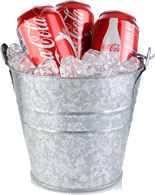A Level Specific Heat Capacity Questions
 Q11.
Q11.
(a) Calculate the energy released when 1.5 kg of water at 18 °C cools to 0 °C and then freezes to form ice, also at 0 °C.
specific heat capacity of water = 4200 J kg-1 K-1
specific latent heat of fusion of ice = 3.4 × 105 J kg-1
(4 marks)
Water cooling to zero
ΔQ = mcΔθ
ΔQ 1= 1.5 × 4200 × 18 
ΔQ 1= 1.1 × 105 (J) 
Ice forming
Δ Q2 = 1.5 × 3.4 × 105 = 5.1 × 105 (J) 
---------------------------
total energy released = 1.1 × 105 + 5.1 × 105
total energy released = 6.2 × 105 J 
(b) Explain why it is more effective to cool cans of drinks by placing them in a bucket full of melting ice rather than in a bucket of water at an initial temperature of 0 °C.
Ice requires an input of latent heat energy to melt.  The ice therefore takes this energy from the drink until it has all melted. This cools the cans before a heat exchange between the drink and melted ice begins. Water at 0 ºC would exchange heat with the cans but only cool them to an intermediate temperature - the ice would cool them to almost zero degrees.
The ice therefore takes this energy from the drink until it has all melted. This cools the cans before a heat exchange between the drink and melted ice begins. Water at 0 ºC would exchange heat with the cans but only cool them to an intermediate temperature - the ice would cool them to almost zero degrees. 
(2 marks)
(Total 6 marks)



 Q11.
Q11. 


